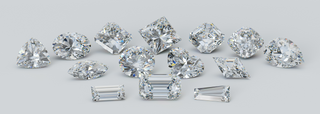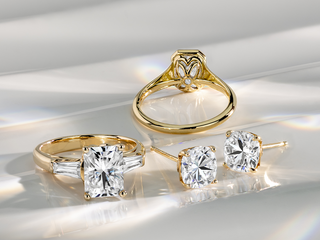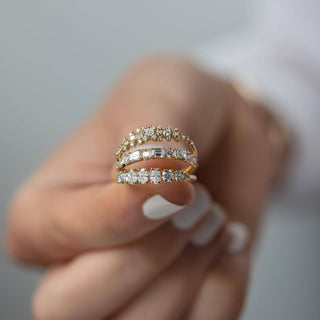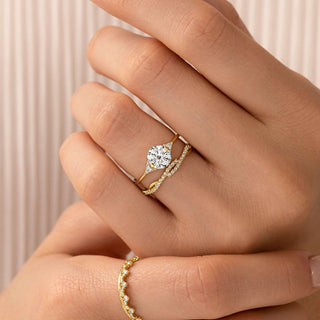

Moissanite
"Your Ultimate Source for Stunning Moissanite"
While moissanite may resemble a diamond, it's important to note that it's not a natural diamond. Much like how an emerald or sapphire differs from a diamond, moissanite possesses distinct chemical properties that make it a genuine gemstone. Created in a laboratory setting, moissanite offers durability comparable to diamonds but at a significantly lower cost. Its affordability, brilliance, and ethical sourcing make it a popular and compelling alternative to traditional diamonds within the jewelry sector.

What is Moissanite?
Moissanite, a silicon carbide gemstone known for its near-colorless appearance, was first identified in 1893 by Henri Moissan, a renowned French scientist who later received the Nobel Prize in Chemistry for his discoveries.
Despite their initial similarities, moissanite and diamonds differ significantly. Moissanites consist of pure silicon carbide, an exceedingly rare mineral found naturally, while diamonds are primarily composed of carbon.
Due to the extreme rarity of natural moissanite, its practical use in jewelry is nearly impossible. Consequently, the moissanite available in today's market is exclusively lab-created to meet the demand for this unique gemstone.

An Eco-Friendly and Durable Alternative to Mined Diamonds
Moissanite, an eco-conscious alternative to mined diamonds, is both durable and affordable. Unlike mined diamonds, moissanites are created in controlled environments using advanced technology, eliminating the need for mining operations entirely. This not only reduces environmental impact but also minimizes the carbon footprint associated with gemstone production.
Investing in moissanite jewelry is not only a sustainable choice but also a practical one. Moissanite gemstones are meticulously crafted to achieve an Excellent Cut, resulting in colorless stones (rated D, E, or F) with exceptional clarity (VS1 or higher). Their superior durability, characterized by a higher tensile strength and lower brittleness compared to diamonds, makes them less susceptible to chipping and cracking, ensuring long-lasting beauty and value.

Choosing the Perfect Moissanite
When selecting a moissanite, factors like cut, color, clarity, and carat weight—commonly known as the four Cs—play a crucial role in determining its value and allure. These elements collectively contribute to the stone's beauty and sparkle.
In terms of cut and clarity, moissanites exhibit consistent excellence across various options. Moreover, moissanites are available in color grades that align with the "Colorless" range (D-F) and the "Near Colorless" range (G-I), offering a spectrum of choices to suit individual preferences. At Browche Elyas Jewelry, we offer Premium and Super Premium moissanites, ensuring the highest quality stones available in the market. Our moissanites and moissanite engagement rings boast VVS1 clarity or higher and DEF color, guaranteeing exceptional brilliance and elegance.
Benefits of Moissanite
Made, not mined.
Eco-friendly
Environmentally friendly, because Moissanite is lab grown, not mined..
More Affordable
Moissanite is less expensive per carat than many other gemstones.
Durability
Moissanite is a 9.25-9.5 on the Mohs Scale of Hardness, so it is suitable for everyday wear.
Perfect
Simulates a perfect diamond and even cuts glass.
Colorless
D color (completely colorless).
Flawless
IF clarity (Internally flawless).
Moissanite Vs Mined Diamonds

Moissanite
Composition: Composed of silicon carbide, moissanite is a naturally occurring mineral found in limited quantities on Earth, but most moissanite used in jewelry is lab-created.
Hardness: Second only to diamonds in hardness on the Mohs scale, moissanite scores 9.25, making it highly durable and resistant to scratching or chipping.
Brilliance and Sparkle: Moissanite: Known for its exceptional brilliance and fire, moissanite exhibits a dazzling sparkle due to its high refractive index, dispersing light into colorful flashes.
Color: Moissanite: Generally, moissanite exhibits minimal to no color and is graded on a color scale from D to K, with D being colorless and K showing slight yellow or gray undertones.
Cost: Moissanite: Moissanite is typically more affordable than diamonds of comparable size and quality, offering an excellent alternative for those seeking brilliance without the high cost.
Origin and Sustainability:Moissanite: Most moissanite available today is lab-created, offering an eco-friendly and sustainable alternative to mined gemstones.
Popularity and Tradition: Moissanite: Growing in popularity as an alternative gemstone for engagement rings and fine jewelry, moissanite offers a modern yet timeless choice for those seeking brilliance and affordability.

Mine Diamond
Composition: Comprised of carbon atoms arranged in a crystalline structure, diamonds are formed deep within the Earth's mantle over millions of years.
Hardness: Diamonds are the hardest natural substance, scoring a perfect 10 on the Mohs scale, making them extremely durable and ideal for everyday wear.
Brilliance & Sparkle: Renowned for its unmatched brilliance, diamonds disperse light beautifully, resulting in a captivating sparkle with a play of light known as "diamond fire."
Color: Diamonds come in a range of colors, from colorless (D) to light yellow or brown, with color grades affecting their value and rarity.
Cost: Diamonds are traditionally more expensive due to their rarity and demand, with factors such as cut, color, clarity, and carat weight influencing their price significantly.
Origin & Sustainability: Mined diamonds have raised concerns regarding environmental impact, labor practices, and ethical sourcing, although efforts are being made to promote responsible mining practices and traceability.
Popularity and Tradition:For centuries, diamonds have epitomized luxury, romance, and tradition, becoming an enduring symbol cherished in engagement rings and cherished for special occasions worldwide.
.

Creation of Moissanites
Moissanites are derived from silicon carbide, their precursor, which is synthesized in high-temperature furnaces mimicking the intense heat and pressure found in meteorites.
Craftspeople utilize the Lely technique to transform these rough silicon carbide crystals into exquisite gems. Named after its inventor, this innovative method involves layering vaporized silicon carbide onto a seed crystal, resulting in moissanites with exceptional fire and brilliance. Unlike diamonds formed deep within the earth, moissanite's higher refractive index allows it to capture light in a mesmerizing kaleidoscope of colors, achieved through controlled scientific processes akin to alchemy.


Tips for Choosing a Moissanite
When it comes to selecting a moissanite, keep these key points in mind:
Assessment Criteria: Unlike diamonds, which undergo evaluations based on carat, cut, color, and clarity, moissanites are primarily appraised based on their cut, color, and clarity. Following this, they are categorized by color and assigned a Brilliant Earth Premium or Super Premium rating.
Color Grading: Premium moissanites are comparable to G–H color diamonds, while Super Premium moissanites fall within the D–E–F color range. The advanced technology used in moissanite creation ensures minimal variation in quality.
Technology and Quality: The high-tech manufacturing processes of moissanites result in consistent quality, making them a reliable choice for those seeking gemstone alternatives.
Before deciding if moissanite is the right gemstone for you, consider its unique characteristics such as fire, scintillation, pricing, and durability compared to diamonds. Understanding these differences will help you make an informed choice that suits your preferences and needs.






